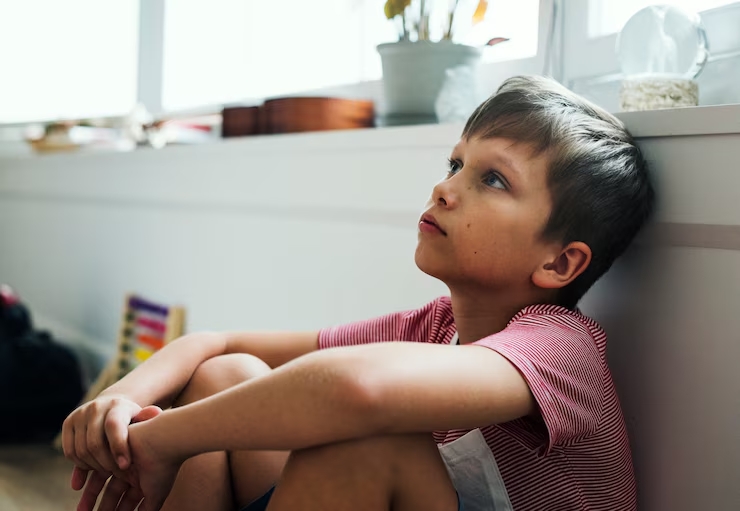Understanding and Managing Anxiety Disorders in Children: A Comprehensive Guide
Comprehensive guide on understanding & managing anxiety disorders in children, offering essential insights & strategies for caregivers.
 In today’s fast-paced and ever-changing world, anxiety disorders among children have become increasingly prevalent. As parents and caregivers, it is crucial to understand and effectively manage these disorders to ensure the well-being and development of our young ones. In this comprehensive guide, we will delve into the complexities of anxiety disorders in children, providing you with valuable insights and practical strategies to navigate this challenging terrain.
In today’s fast-paced and ever-changing world, anxiety disorders among children have become increasingly prevalent. As parents and caregivers, it is crucial to understand and effectively manage these disorders to ensure the well-being and development of our young ones. In this comprehensive guide, we will delve into the complexities of anxiety disorders in children, providing you with valuable insights and practical strategies to navigate this challenging terrain.
From separation anxiety and specific phobias to generalized anxiety disorder and social anxiety, we will explore the different types of anxiety disorders that can manifest in children. Drawing on the latest research and expert advice, we will uncover the underlying causes and risk factors, while shedding light on common signs and symptoms to look out for.
Moreover, this guide will equip you with a range of evidence-based management techniques, including cognitive-behavioral therapy, relaxation exercises, and mindfulness techniques. We will also address the important role that parents, educators, and healthcare professionals play in supporting children with anxiety disorders.
Take a proactive approach in understanding and managing anxiety disorders in children. By gaining knowledge and implementing effective strategies, we can empower our young ones to navigate their fears and worries, fostering their overall well-being and resilience.
Different Types of Anxiety Disorders in Children
Anxiety disorders can manifest in various forms in children. It is important to recognize these different types to better understand the specific challenges they present. One common type is separation anxiety, where children experience excessive fear and distress when separated from their parents or primary caregivers. Specific phobias, such as fear of animals or heights, are also prevalent in children and can significantly affect their daily lives.
Generalized anxiety disorder (GAD) is another type of anxiety disorder that is characterized by excessive worry and fear about various aspects of life, such as school performance, social interactions, and personal safety. Social anxiety, on the other hand, involves an intense fear of being judged or embarrassed in social situations, leading to avoidance and isolation.
Signs and Symptoms of Anxiety Disorders in Children
Recognizing the signs and symptoms of anxiety disorders in children is crucial for early intervention and support. While each child may exhibit unique symptoms, some common signs include excessive worrying, restlessness, irritability, difficulty concentrating, and physical symptoms like headaches or stomachaches. Sleep disturbances, changes in appetite, and avoidance of certain activities or places may also indicate the presence of anxiety.
 Causes and Risk Factors of Anxiety Disorders in Children
Causes and Risk Factors of Anxiety Disorders in Children
Anxiety disorders in children can arise from a combination of genetic, environmental, and developmental factors. Some children may be more predisposed to anxiety due to a family history of anxiety disorders or other mental health conditions. Environmental factors such as traumatic experiences, high levels of stress, or a chaotic home environment can also contribute to the development of anxiety disorders. Additionally, certain personality traits, such as being highly sensitive or perfectionistic, can increase a child’s vulnerability to anxiety.
Diagnosing Anxiety Disorders in Children
Diagnosing anxiety disorders in children requires a comprehensive evaluation by a healthcare professional or mental health specialist. The diagnostic process typically involves a thorough assessment of the child’s symptoms, medical history, and family history. The healthcare professional may also use standardized questionnaires and interviews to gather additional information. It is important to remember that anxiety disorders in children can coexist with other mental health conditions, such as depression or attention-deficit/hyperactivity disorder (ADHD).
Treatment Options for Anxiety Disorders in Children
Fortunately, there are various treatment options available to help children manage and overcome anxiety disorders. One of the most effective forms of treatment is cognitive-behavioral therapy (CBT). CBT helps children identify their anxious thoughts and beliefs and teaches them techniques to challenge and reframe these thoughts. It also incorporates exposure therapy, where children are gradually exposed to their fears in a controlled and supportive environment.
In some cases, medication may be prescribed alongside therapy to help manage severe anxiety symptoms. Medications such as selective serotonin reuptake inhibitors (SSRIs) can be effective in reducing anxiety symptoms, but it is essential to discuss the benefits and potential risks with a healthcare professional.
Cognitive-Behavioral Therapy for Anxiety Disorders in Children
CBT is a widely recognized and evidence-based treatment for anxiety disorders in children. It focuses on helping children develop coping skills and strategies to manage their anxiety. Through CBT, children learn to identify and challenge their anxious thoughts, develop relaxation techniques, and gradually face their fears through exposure therapy. CBT can be conducted individually or in a group setting, depending on the child’s needs and preferences.
Medications for Anxiety Disorders in Children
In some cases, medication may be recommended as part of the treatment plan for anxiety disorders in children. Medications such as SSRIs can help regulate brain chemistry and reduce anxiety symptoms. However, medication should always be prescribed and monitored by a qualified healthcare professional, as each child’s needs and response to medication may vary. Regular check-ins and adjustments to the medication dosage may be necessary to ensure its effectiveness.
Tips for Managing Anxiety Disorders in Children at Home and School
Managing anxiety disorders in children requires a collaborative effort between parents, educators, and healthcare professionals. Here are some practical tips for supporting children with anxiety:
1. Create a calm and structured environment at home, with predictable routines and clear expectations.
2. Encourage open communication and provide a safe space for children to express their fears and worries.
3. Teach relaxation techniques, such as deep breathing exercises or progressive muscle relaxation, to help children manage their anxiety in stressful situations.
4. Work with teachers and school staff to create a supportive and inclusive environment for children with anxiety disorders. This may involve implementing accommodations, such as extra breaks or modified assignments.
5. Foster a positive and non-judgmental attitude towards anxiety, emphasizing that it is a common and manageable condition.
 Conclusion and Resources for Further Support
Conclusion and Resources for Further Support
Understanding and managing anxiety disorders in children is a complex but essential journey. By recognizing the different types, signs, and symptoms of anxiety, we can intervene early and provide the necessary support. With the right combination of therapy, medication, and a supportive environment, children with anxiety disorders can learn to navigate their fears and worries, fostering their overall well-being and resilience.
Remember, this comprehensive guide is just the beginning. If you or someone you know is seeking additional support, it is important to reach out to qualified healthcare professionals or mental health organizations. They can provide further guidance, resources, and tailored strategies to help children and families on their path to managing anxiety disorders.




